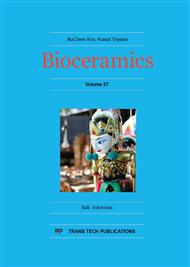[1]
A. Astvaldsdottir, J. Dagerhamnb, J.W.V. van Dijken, A. Naimi-Akbar, G. Sandborgh-Englund, S. Tranæus, M. Nilsson, Longevity of posterior resin composite restorations in adults – A systematic review. J Dent 43 (2015) 934 – 954.
DOI: 10.1016/j.jdent.2015.05.001
Google Scholar
[2]
V. Moraschini, C.K. Fai, R.M. Alto, G.O. dos Santos, Amalgam and resin composite longevity of posterior restorations: A systematic review and meta-analysis. J Dent 43 (2015) 1043–1050.
DOI: 10.1016/j.jdent.2015.06.005
Google Scholar
[3]
N.J. Opdam, E.M. Bronkhorst, B.A. Loomans, M.C. Huysmans, Longevity of repaired restorations: A practice based study. J Dent 40 (2012) 829 – 835.
DOI: 10.1016/j.jdent.2012.06.007
Google Scholar
[4]
M. Rinastiti, M. O¨ zcan, W. Siswomihardjo, H.J. Busscher, H.C. van der Mei, Effect of biofilm on the repair bond strengths of composites. J Dent Res89 (2010) 1476–81.
DOI: 10.1177/0022034510381395
Google Scholar
[5]
M.O. Sharif, M. Catleugh, A. Merry, M. Tickle, S.M. Dunne, P. Brunton P, V.R. Aggarwal, Replacement versus repair of defective restorations in adults: resin composite, Cochrane Database Systematic Review 17 (2010) CD005971.
DOI: 10.1002/14651858.cd005971.pub2
Google Scholar
[6]
T. Shimane, K. Endo, J. H. Zheng, T. Yanagi, H. Ohno, Wear of opposing teeth by posterior composite resins: evaluation of newly developed wear test methods, Dent Mater 29 (6) (2010) 713–720.
DOI: 10.4012/dmj.2008-031
Google Scholar
[7]
M. Quirynen, The clinical meaning of the surface roughness and the surface free energy of intra-oral hard substrata on the microbiology of the supra- and subgingival plaque: results of in vitro and in vivo experiments, J Dent 22 Suppl 1(1994).
DOI: 10.1016/0300-5712(94)90165-1
Google Scholar
[8]
S. D. Heintze, M. Forjanic, K. Ohmiti, V. Rousson, Surface deterioration of dental materials after simulated toothbrushing in relation to brushing time and load, Dent Mater 26 (4) (2010) 306–319.
DOI: 10.1016/j.dental.2009.11.152
Google Scholar
[9]
B.B. Monteiro, Surface roughness of composite resins after simulated toothbrushing with different dentifrices, JIOH 7(7) (2015) 0976-7428.
Google Scholar
[10]
G.M. Barbieri, E.G. Mota, S.A. Rodrigues-junior, L. H Burnett Jr. Effect of whitening dentifrices on the surface roughness of commercial composites, J Esthet Restor Dent 23 (2011) 338–334.
DOI: 10.1111/j.1708-8240.2011.00426.x
Google Scholar
[11]
G. Eliades, T. Eliades, M. Vavuranakis. General aspect of biomaterial surface alterations following exposure to biologic fluids, in: Eliades G et al. (Eds) Dental material in vivo: aging and related phenomena, Quintessence Publishing Co. Inc., 2003, pp.3-20.
Google Scholar
[12]
M. Quirynen, M. Marechal, H.J. Busscher, A.H. Weerkamp, P.L. Darius, D. Van Steenberghe, The influence of surface free energy and surface roughness on early plaque formation, J Clin Periodontol 17(1990) 138-144.
DOI: 10.1111/j.1600-051x.1990.tb01077.x
Google Scholar
[13]
R.L. Sakaguchi, J.M. Power, Craig's restorative dental materials 13th Ed. Mosby Inc., (2012).
Google Scholar
[14]
J. Janus, G. Fauxpoint,Y. Arntz, H. Pelletier, O. Etienne, Surface roughness and morphology of three nanocomposites after two different polishing treatments by a multitechnique approach, Dent Mater 26 (5) (2010) 416–425.
DOI: 10.1016/j.dental.2009.09.014
Google Scholar
[15]
D. Lefever, N. Perakis, M. Roig, I. Krejci, S. Ardu, The effect of toothbrushing on surface glass of resin composites, Am J Dent 25 (1) (2012) 54–58.
Google Scholar
[16]
N. Garg, A. Garg, Textbook of operative dentistry 2nd Ed., Jaypee Brothers Medical Publisher, New Delhi, 2013, pp.50-53.
Google Scholar
[17]
S. Kumar, M. Kumari, S. Acharya, R. Prasad, Comparison of surface abrasion produced on the enamel surface by a standard dentrifice using three different toothbrush bristle design: A profilometric in vitro study, J Conserv Dent 17(4) (2014).
DOI: 10.4103/0972-0707.136513
Google Scholar
[18]
M. Ono, T. Nikaido, M. Ikeda, S. Imai, N. Hanada, J. Tagami, K. Martin, Surface properties of resin composite materials relative to biofilm formation, Dent Mater J 26(5) (2007) 613-622.
DOI: 10.4012/dmj.26.613
Google Scholar
[19]
R. P. Sousa, I. C. J. Zanini, J. P. M. Lima, S. M. L. C. Vasconcelos, M. A. S. Melo, H. C. P. Beltrao, L. K. A. Rodrigues. In situ effect of restorative materials on dental bofilm and enamel demineralization, J Dent 37 (2009) 44-51.
DOI: 10.1016/j.jdent.2008.08.009
Google Scholar
[20]
M. Gharaechahi, H. Moosavi, M. Forghani, Effect of surface roughness and materials composition on biofilm formation, JBNB 3 (2012) 541-546.
DOI: 10.4236/jbnb.2012.324056
Google Scholar
[21]
R. R. Moraes, D. S. Ribeiro, M. M. Klumb, W. C. Brandt, L. Correr-Sobrinho, M. Bueno. In vitro toothbrushing abrasion of dental resin composites: packable, microhybrid, nanohybrid dan microfilled materials, Braz Oral Res 22(2) (2008) 112-118.
DOI: 10.1590/s1806-83242008000200004
Google Scholar
[22]
G. U. Oliveira, R. F. L. Mondelli, M. C. Rodrigues, E. B. Franco, S. K. Ishikiriama, L. Wang, Impact of filler size and distribution on roughness and wear of composite resin aster simulated toothbrushing, J Appl Oral Sci (2011) 510-516.
DOI: 10.1590/s1678-77572012000500003
Google Scholar
[23]
H. Kyoizumi, J. Yamada, T. Suzuki, M. Kanihera, W. J., Finger, K. Sasaki, Effect of toothbrush hardness on in vitro wear and roughness of composite resins. JCDP 14(6) (2013) 1137-1144.
DOI: 10.5005/jp-journals-10024-1464
Google Scholar
[24]
S. Haldal, Shashikala, P. Rajesh, S. S. Ali, Quantitative assassment of the surface roughness of two esthetic restorative materials after tooth brush abrasion using 3-D profilometer and Scanning Electron Microscope, IJHSR 3(1) (2013) 43-49.
Google Scholar
[25]
T. Suzuki, H. Kyoizumi, Y. Araki, W. J. Finger, M. Kanehira, Toothbrush abrasion of resin composites with different filler concepts, World J Dent 3(2) (2012) 184- 193.
DOI: 10.5005/jp-journals-10015-1154
Google Scholar
[26]
M. Toledano, R. Osorio, A. Osorio, V. Fuentes, C. Prati, F. Garcia-Godoy, Sorption and solubility of resin-based restorative dental materials, J. Dent 31 (2003) 43-50.
DOI: 10.1016/s0300-5712(02)00083-0
Google Scholar


